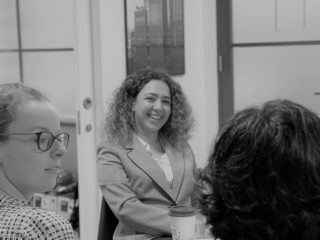CO-RE hosts roundtable to explore what younger professionals want for the office

Building on CO—RE’s 2021 survey of senior executives from London’s leading occupiers, we hosted a roundtable discussion with the next generation of talented professionals in the commercial property sector to find out what they’re observing in the market and what they look for from their own office environment.
Alex Parsons, Jo Al-Hillawi, James Chester and Dolunay Dogahan from our development management team were joined by Hannah Day, Managing Associate - Real Estate at Linklaters, George Kekatos, Cultural Partnerships Manager at Futurecity, Olga Turner, Director & Co-founder of Ekkist, Jack Measom, Director at BH2, Libby Butler, Development Manager at Kajima, Robert Vasili, Architect at Orms, Georgia Lilley, Design Engineer at Waterman and Niamh Sutherland, Senior Engineer at Momentum Transport.
Our earlier research indicated that occupiers are embracing the hybrid model (71% in 2021). But a year on, is hybrid here to stay? And is it supported at all levels?
At Futurecity, creative meetings take place in the office and desk research and writing happens at home. “We go in the office to collaborate,” explained George. But when it comes to collaboration, virtual meetings were a subject of hot debate amongst the group. James talked about the challenge of working on projects with large teams of external consultants: “To pull everyone in the same direction is difficult unless you meet in person.” But Olga has found the ability to screenshare a revelation for productivity: “Before, someone might say that they have a good example but will have to send it to you later. Now everything is instant.”
No doubt it helps to be able to read people’s reactions, so for Robert, being together with a big screen that that you can scribble all over is the best of both worlds. That’s something that occupiers seem keen to cater to, with digital infrastructure ranking as their second highest priority in our 2021 research, after good transport connections.
It is also crucial to consider the youngest members of the team and create an environment where they can learn and feel involved. To “bring them along on the journey”, as Jo put it. Having done an apprenticeship scheme herself, Georgia emphasised how helpful it is to be in an office environment where you learn from hearing and seeing things around you. And James added that it’s not just about letting more junior team member absorb thing but being there to encourage them to speak up too. “It is not easy to create an open, collaborative environment on Teams,” George admitted, “I personally have no problem jumping into a 40-person virtual meeting and voicing an idea. But it can be harder for newer members of the team.”
Our Chief Executive, Bradley Baker, had observed from leading occupiers’ responses to our survey that increasingly brands want sustainable, healthy and well-designed workspaces that reflect their values and help them attract and look after their talent.
“When the pandemic hit, some people ended up working on ironing boards and there was also a rise in mental health problems,” said Dolunay, raising that not everyone has a great set up at home. She argued that from the basics of a desk to the benefits of access to outdoor space, the office environment can be a real draw – for younger talent especially. Hannah added that for a lot of people of all ages who live on their own, loneliness is a big problem that the office plays an important role in counteracting: “You come in to be with your colleagues and have conversations.”
Alex also wants to be in the office on the busiest days, when there is “a buzz”. But this does create a challenge for managing peak occupancy, particularly with the rise of hotdesking. Jack said that working out how much space is needed has gone from being a quick calculation to a complex set of ratios. Maximum flexibility is key, according to Libby, “in case the space isn’t used how you thought”. Niamh was keen for office space to be designed with flexibility in mind as the office is used differently now and the space needs to reflect this, providing space for in-person meetings and office social activities.
Space to do yoga, and for a wide range of other amenities, seems like a non-negotiable and a crucial differentiator. From wellness facilities to auditorium space for talks, Alex said: “The office needs to be more than a home from home. It needs to be more than a desk with a good internet connection.” For law firms like Linklaters, space to entertain is just as important. Hannah said: “We’re a people business that thrives on having the best talent and being able to host clients.”
Sustainability is always front of mind for the group. Dolunay said: “In a world where we are trying to be less wasteful, you need to be critical about what is adding value.” Is placemaking the answer to ensuring that value is maximised? George thinks so: “Before, buildings were designed just as places to work. Now they’re designed for people to do the best work they can. An outdoor terrace, for example, can be more than a terrace when it is actively programmed and a person working in the building can participate in something cultural or educational.”